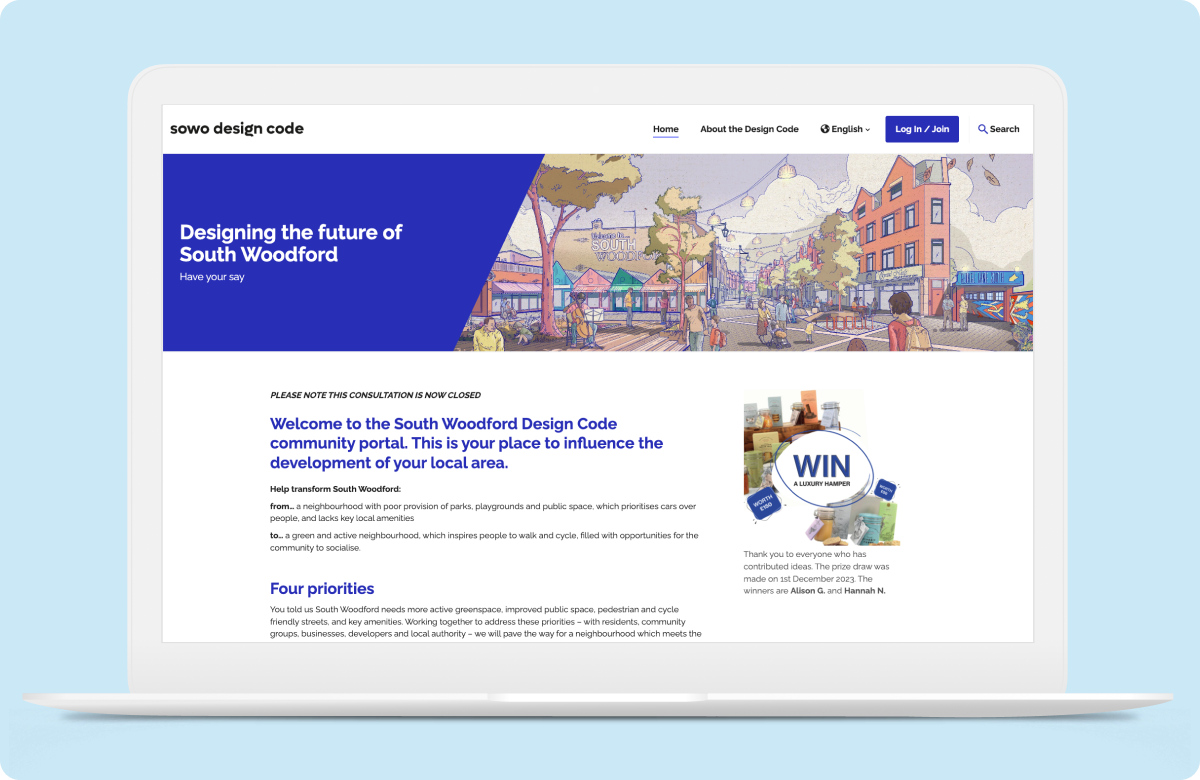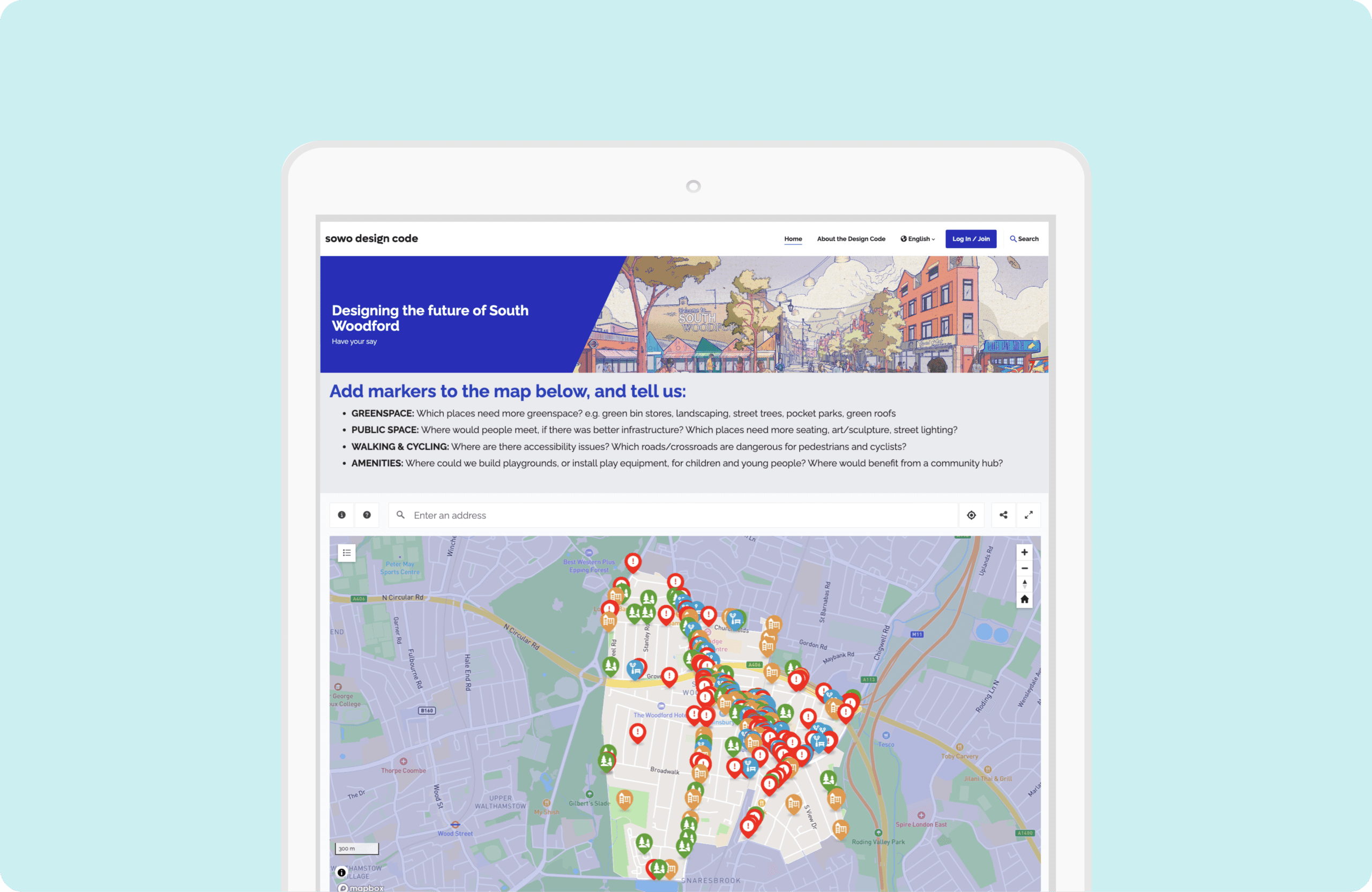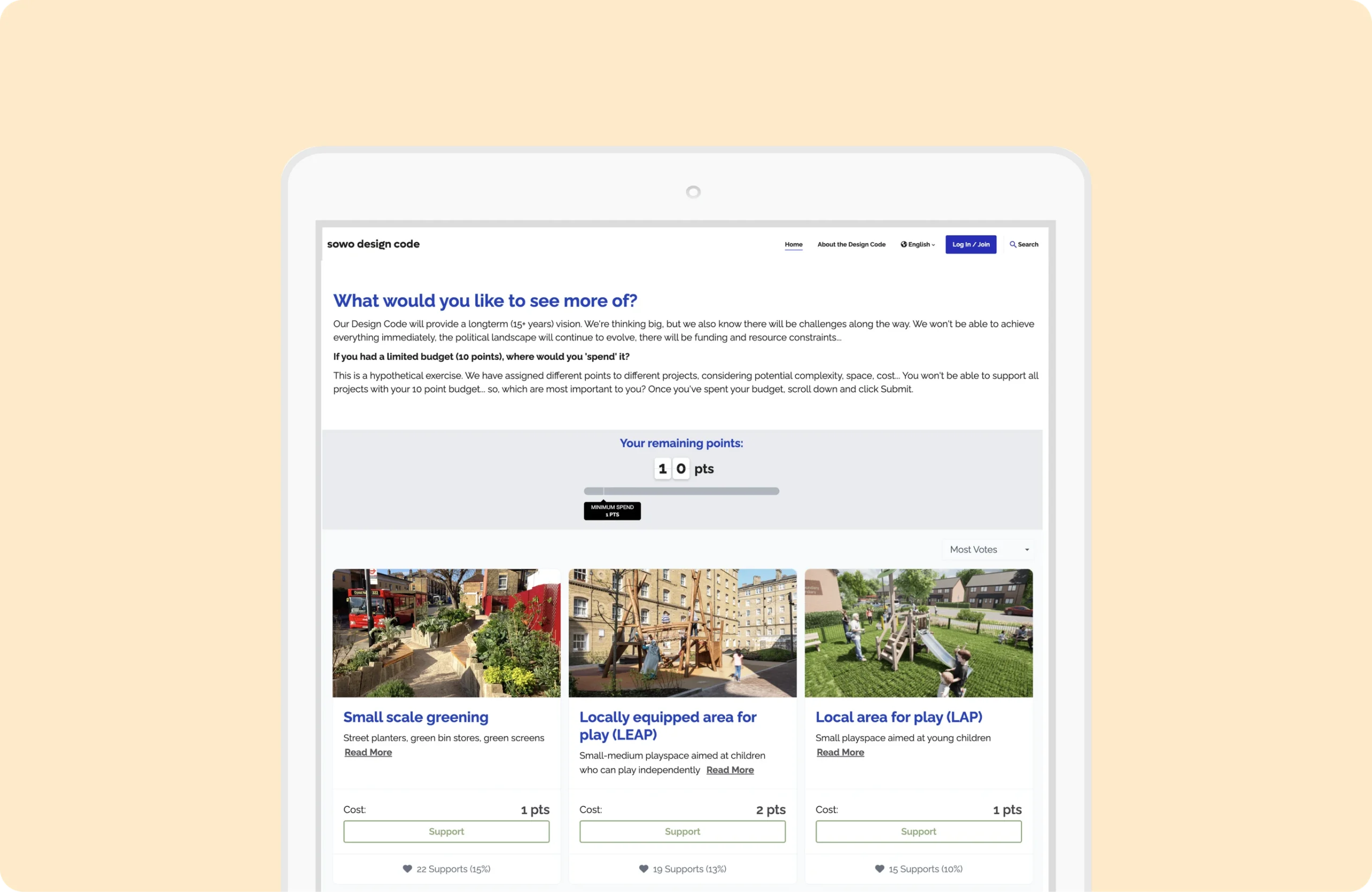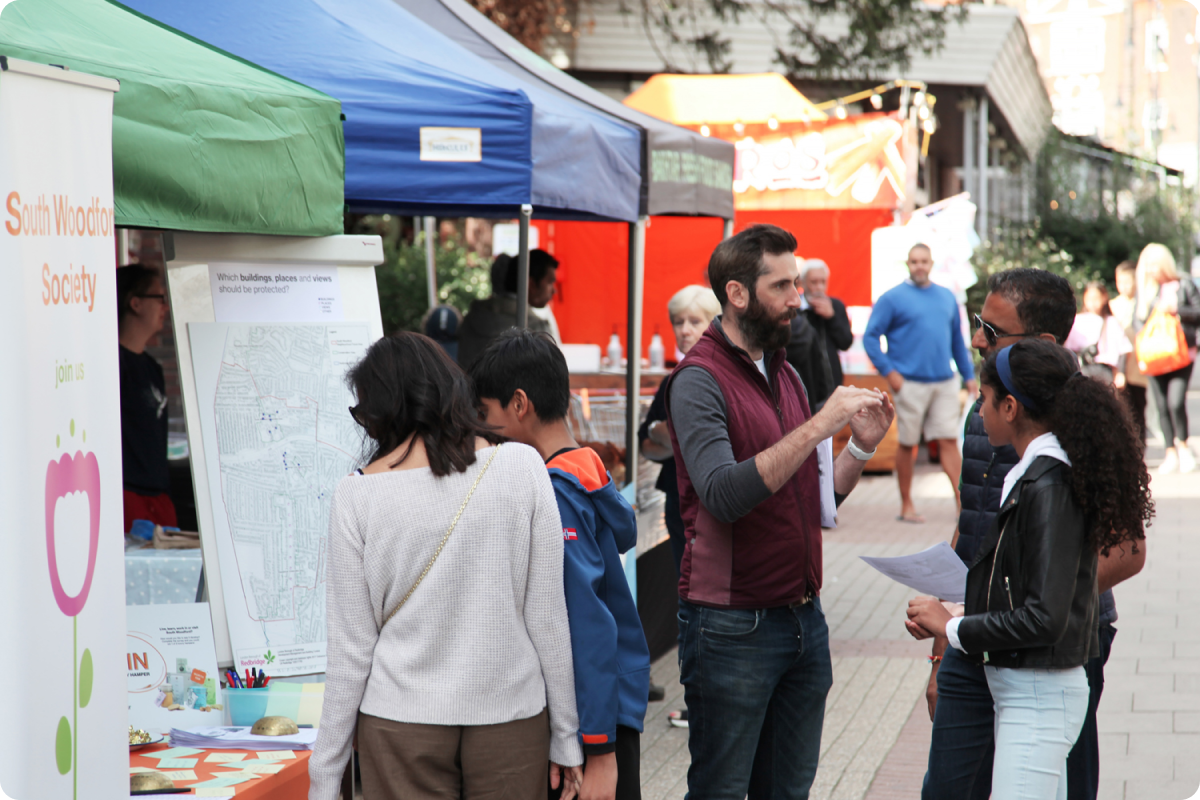About The South Woodford Society
South Woodford is a vibrant suburb in North East London, located in the borough of Redbridge. In 2015, a group of local residents created The South Woodford Society to help establish a Neighbourhood Plan for South Woodford. Today, the Society’s membership has expanded to over 600 households, spanning more than 3000 individuals online in and around South Woodford, E18.
In March 2022, the South Woodford Neighbourhood Forum (SWNF) was chosen as one of just four neighbourhood forums in England to join the Design Code Pathfinders Programme, along with 21 local authorities. This program gives communities a voice in shaping their streets, public areas, buildings, and natural spaces. Since the Society was selected, they have been working with AzuKo, native north architects, and JKA to help create this Design Code.
“This Code will set the community’s expectations for design quality and future development within their neighbourhood. Architecture charity, AzuKo is leading the engagement process. We were specifically brought on to ensure the Code represents this diverse community in northeast London.”
– Jo Ashbridge (CEO, AzuKo)
The Goal
Expand outreach and actively engage more residents in South Woodford.
In August 2022, the Society actively sought input from the community to gain a better understanding from residents about what facilities they would like to see in the neighbourhood. To reach a wide range of demographics, they employed a hybrid engagement approach, blending online digital tools with face-to-face participation.
This included surveys (both digital and paper), pop-up stalls at a local market, 3 themed walking tours, 2 focus groups, and 6-in-depth interviews including email, telephone, and in-person conversations. The consultation took place over 13 weeks, between August and October 2022.
During this initial phase, 402 people from the community actively engaged, leading to the identification of four primary priorities within South Woodford. These priorities encompassed green spaces, public areas, walking and cycling infrastructure, and amenities.
View the consultation report here.
The Approach
Utilising Social Pinpoint for effective hybrid engagement to compliment The South Woodford Society’s offline initiatives.
Before adopting Social Pinpoint, the Society encountered challenges with collecting feedback for specific locations. The team believed that adopting a hybrid approach would create additional opportunities for community involvement.

To extend its reach digitally to the wider community, the Society chose Social Pinpoint. It deployed its new Have Your Say public engagement site during the second phase of consultations, which targeted the four main priorities that were identified in the initial first stage. This consultation was conducted from October to December 2023 through an online community portal. Everyone who either lived in or had an interest in South Woodford was invited to share their views; those who live, learn, work in or regularly visit the area.
The portal featured the popular Social Map digital tool to capture, visualise, and analyse place-based feedback within the South Woodford Neighbourhood Forum area by enabling the community to show exactly where their ideas or concerns related to. Spatial patterns and trends helped to identify problem spots and uncover ideas for improvements.

“The platform has helped us dig deeper into our community’s needs, their hopes and dreams for future development in South Woodford. We centred the engagement on an interactive map, which has provided rich, place-based data. We’re using the findings to shape our Design Code, and create a vision for 2040.”
– Pearl Arbenser-Simmonds (Co-Chair, The South Woodford Society, London, UK)
“I know the Society has been incredibly impressed with the digital portal, particularly the map. I don’t think they thought they could create something like that. I can imagine any local group would want the ability to have this type of community portal – it has allowed us to gain such in depth data.”
– Jo Ashbridge (CEO, AzuKo)
The Society also leveraged a variety of other digital engagement tools offered by Social Pinpoint, such as the Fund It tool, Gather, and the Form Tool. For instance, by utilising the Fund It tool, they found that community members were ‘spending’ on the smaller solutions instead of the big projects that would require huge investment and political weight.

This was an insightful exercise because the tool forced people to consider what they were able to get for the budget they had. Interestingly some were hoping to increase their budget so that they could achieve more, but it proved to be a great exercise in compromise.
“We had a few people respond to us initially to say, ‘I want more hypothetical money’. We talked it through with them, explaining thatit’s an example of a real life scenario. Funding for community works is always challenging, the reality is we’re going to have barriers to creating any of these ideas. We gathered a lot of interesting data from it and they really felt like their response mattered.”
– Jo Ashbridge (CEO, AzuKo)
By offering methods for both offline and online engagement, it allowed more community members to be able to share their thoughts and ideas. Using these engagement tools gave the Society a better way to connect with residents online, ensuring a wide range of voices were heard and valued in the decision-making process.

“Social Pinpoint, and the array of digital tools it offers – mapping and community ‘notice boards’ to funding priority tools – is a fantastic way to complement offline engagement. It means that those who don’t have the time or resources to join in-person workshops for example, can contribute. It’s a really collaborative platform, which supports individual ideas and collective discussions. We also printed off maps and shared them with local businesses, nursing homes, and different venues to expand reach to groups such as the elderly who might not feel comfortable contributing digitally. They could contribute to the map just by hand and then share their ideas with us.”
– Jo Ashbridge (CEO, AzuKo)
The Results
Gained deeper understanding of the community’s four priorities and fostering public support.
The community portal for the South Woodford Design Code saw significant engagement, with over 3,400 views from 1,175 unique visitors. This activity resulted in 377 contributions, including over 280 geospatial map markers. What is particularly noteworthy is that 87% of these contributors were residents of South Woodford, which indicates a strong local interest with residents wanting to be involved in the project.
Among the array of engagement tools that were utilised, the interactive map became the most popular choice, with posts typically receiving an average of three votes each, showcasing active community participation and feedback.
Due to the Society’s combined offline and online engagement strategies, they have gained further insight into the four priorities that were identified during the first consultation. The Society found that the community has a strong interest in promoting walking, cycling, and green spaces over vehicular use. Interestingly, this contradicts certain media perceptions, which highlights the importance of directly and transparently gathering meaningful feedback from the community!
For a comprehensive overview of the consultation, you can access and read their latest report here.
The Future
With broad community support, The South Woodford Society anticipates the Design Code to become a part of the planning policy.
Currently the Society is actively developing a GIS map to visualise the community’s assets and goals. This initiative includes a dedicated website or portal where residents will be able to explore and understand the data, offering insights into the community’s present state and future aspirations for South Woodford.
The data that the Society collected through engagement will help shape the next iteration of the Design Code. Around mid/end-2025, the Society predicts that the Code will become part of the planning policy, following a Neighbourhood Plan referendum. This voting process exists to ensure the community does indeed agree with the vision and content.
“The South Woodford Society are pioneers. What they are doing really is a blueprint for what a community can create. Making changes to planning policy is truly difficult. The South Woodford Society should be celebrated – they’re just brilliant. They are a women led group and they don’t take no for an answer.”
– Jo Ashbridge (CEO, AzuKo)




